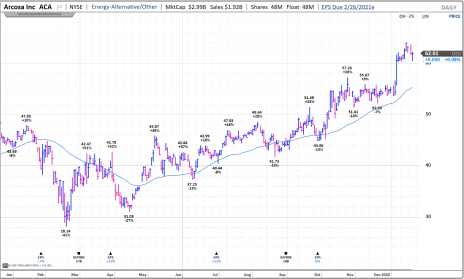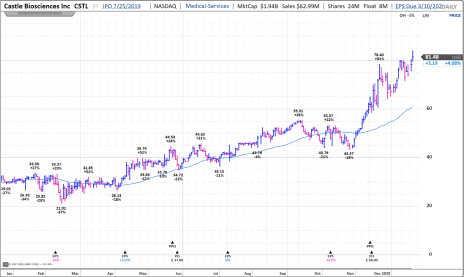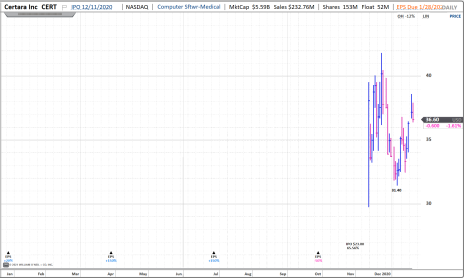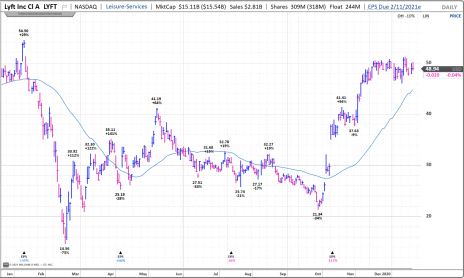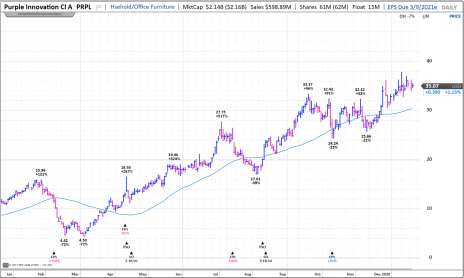In January’s Issue of Cabot Early Opportunities we take a trip down memory lane to January 2020, and try to take some of our own advice that seems even more timely now.
We also dig into five stocks that cover a wide variety of end market exposures. We unpack a small stock that represents a play on infrastructure and clean energy, two rising stars in MedTech, a consumer name that just won’t quit and even a beaten down growth stock that should recover as people get back out there later in 2021.
As always, there should be something for everyone!
Cabot Early Opportunities 117
| Stock Name | Market Cap | Price | Investment Type |
| Arcosa (ACA) | $3.0 billion | 62.01 | Growth & Value – Infrastructure & Energy |
| Castle Biosciences (CSTL) | $1.9 billion | 81.48 | Rapid Growth – Genetic Testing |
| Certara (CERT) | $5.6 billion | 36.60 | Growth – Biosimulation Software |
| Lyft (LYFT) | $15.5 billion | 48.94 | Rapid Growth – Ridesharing |
| Purple (PRPL) | $2.2 billion | 35.07 | Rapid Growth – DTC Mattresses |
Still Rallying
As we wade deeper into winter here in the Northeast, I’m reminded of something I wrote about the similarities of investing in a bull market and skiing in powder. It was from almost exactly one year ago, on January 15, 2020.
Here’s what I wrote:
“Hero snow is what you get when you’ve had lots of medium size storms that skiers work into the mountain and which create a superb base. Then you get a big storm that turns the mountain into a massive playground.
Skiing in hero snow is about the most fun thing you can do. It makes everybody better!
The only downside is that it is tempting to do things you wouldn’t otherwise do. Sure, taking some risks is part of the fun. But where do you draw the line when the conditions make you feel like one of the Avengers?
I distinctly remember one day many years ago, skiing at a small resort named Castle Mountain in Alberta, Canada. A series of storms had come through and there was about 18 inches of fresh, light snow that the cold weather kept soft as a feather.
It was 100% hero snow. On one run I did a big, arcing turn in untracked snow on a part of the trail that resembled something like a massive halfpipe. As it turns out the lip, where I really leaned into my turn, was some of that good Alberta rock, hidden under a thin layer of powder (something the locals probably knew).
After a phenomenal yard sale in which I lost every piece of equipment without my DNA, I picked myself up, checked to make sure all limbs were still attached (they were), and assessed the damage to my skis. They were destined for the dumpster but would get me through the rest of that day – which I moved through with much more caution.
Investing in the current stock market is the equivalent of skiing in hero snow. It seems hard to go wrong!”
Back to the present, January 2021 …
This analogy of investing in a bull market and skiing in lots of powder feels timely for two reasons. I got to ski in powder this past weekend, and we’re killing it in the stock market. Less than one year after one of the worst market crashes in history we are skiing in hero snow again.
That’s quite amazing. And many of us following the market think 2021 will be another good year, albeit with normal pullbacks (and maybe some abnormal ones too) along the way.
As always, people like me who recommend stocks for a living are still trying to ride a fine line between aggressively buying high-growth stocks while simultaneously trying to tamp down enthusiasm so nobody gets hurt.
My closing comments from back in January ring as true now as they did then.
“This environment makes us all feel a little too invincible. That’s the danger of hero snow … and investing in a market where just about everything is going higher.”
Don’t get me wrong … I love it. High fives, fist bumps and backslaps on our investing success are most definitely well-deserved. After all, you don’t earn the reward if you don’t take any risk.
But at the same time, it’s important to recognize that the market has made investing just a little too easy lately. Let’s keep it in the backs of our minds that at some point a little damage will be inflicted upon us.
What to Do Now
Stay invested but proceed cautiously with respect to new buying.
A pullback or deeper correction could be right around the corner, or months away. To balance out the risks be sure to average into new positions and accumulate a full position over time.
In terms of selling, continue to trim positions that just haven’t worked and/or that, upon further review, you don’t expect to maintain conviction in through a drawdown.
As always, don’t be afraid to take some partial profits here and there. The end goal is to be able to participate in the big, sustained moves, while sleeping well at night.
STOCKS
Arcosa (ACA)
We’re far from being value investors but I would be remiss not to include one stock this month that has a little value flavoring given the market’s appetite for such offerings. Arcosa (ACA), which has a market cap just under $3 billion, caught my eye because of its end market exposure to infrastructure and clean energy, and I’m impressed by the strength the stock has shown since it spun off from Trinity Industries (TRN) in November 2018.
What does it do?
Arcosa provides infrastructure-related products and solutions to the construction, energy, and transportation markets in North America. Growth should be strong in the years ahead as the U.S. seeks to replace and improve its aging transportation and energy infrastructure while growing the mix of clean and renewable power generation.
Arcosa’s biggest segment (46% of revenue) is Energy Equipment, which makes wind towers, steel storage tanks (for propane, ammonia, etc.) and electric utility structures.
The Construction Projects segment (28% of revenue) supplies a variety of aggregates (sand, gravel, limestone), specialty materials (lightweight aggregates for roads, bridges, green buildings, etc.) and steel and aluminum trench shoring and shielding equipment (for protecting in-ground construction/utility-related holes and trenches from collapsing).
Finally, the Transportation Products segment (26% of revenue) makes barges and marine hardware, as well as products for railroads (railcar coupling devices, axles, etc.).
Since the 2018 spin off from Trinity, Arcosa’s management team has executed on its growth plan across all three divisions. It has completed growth-oriented acquisitions, added new product lines, expanded manufacturing capacity and geographic reach, and managed to grow margins.
Even with the pandemic, revenue over the last twelve months (ending September 2020) was up 11%. Analysts see full-year 2020 revenue up by 12%, to $1.9 billion and adjusted EPS up 7%, to $2.52. Arcosa pays a small dividend of $0.20 per quarter, equal to a yield of 0.3%.
Looking into 2021, investors should expect Arcosa to focus on its construction and energy divisions. Infrastructure projects, including the 5G telecom buildout and renewable power distribution projects should fuel growth. The transportation products business may deliver mixed results as higher demand for certain things (like grain) is offset by lower demand for others (crude oil and refined products).
Add it all up and analysts currently see growth in 2021 being flat on both the top and bottom lines. However, I suspect that with the new administration focused on getting the economy going again, a (hopefully) easing pandemic, and access to low-cost financing, Arcosa will be relatively aggressive pursuing growth opportunities that will bring bigger investors into the stock.
The Stock
ACA came public in November 2018 when it was spun out of Trinity Industries (TRN) near 26. While there were some dips, the stock did well and was trading near 48 in February 2020 just before the pandemic hit. Shares sold off until they bottomed at 28. The recovery began with fits and starts but smoothed out last summer and ACA reached its pre-pandemic high by early-September. A brief selloff of 14% followed, but ACA advanced above 50 in November, consolidated in the 52 to 57 range through the end of the year, then broke out to trade above 60 on January 6. It has since traded as high as 64, but with a little pullback this week, investors should look to buy near 60, or preferably a little lower.
Castle Biosciences (CSTL)
Castle Biosciences (CSTL) develops diagnostic and prognostic tests for skin cancers that inform personalized treatment plans based on tumor-specific genomic information.
While the company has a market cap of less than $2 billion, it has come a long way since it was formed in 2008. Progress has accelerated over the last year too. Entering 2020 Castle had an addressable market in the U.S. of $540 million. With two new tests launched over the last twelve months (DecisionDx-SCC and DecisionDx DiffDx-Melanoma), Castle’s addressable market has grown to over $2 billion.
The company is currently focused on three dermatological cancer products addressing three markets, and one test for eye cancer.
DecisionDx-UM is the standard of care for uveal melanoma, a rare eye cancer that affects roughly 1,600 people in the U.S. each year.
The DecisionDx-Melanoma test is a proprietary gene expression profile (GEP) test that tries to predict a patient’s risk of metastasis or recurrence, as well as sentinel lymph node positivity. It addresses a $540 million market comprised of roughly 130,000 patients.
DecisionDx-SCC (squamous cell carcinoma) is also a GEP test and addresses an $820 million market with around 200,000 patients. It is designed to predict metastatic risk for high-risk patients.
Finally, DecisionDx-DiffDx Melanoma, the newest test, is designed to give a highly accurate and objective result to help characterize suspicious pigmented lesions. The design for the test came about because of the market’s need to characterize difficult-to-diagnose lesions. Data shows it has a 96% technical success rate, classifying lesions as either benign, intermediate-risk or malignant. It addresses a $600 million market with around 300,000 patients.
It takes a little time to ramp products up and gain insurance coverage, but Castle is making considerable progress. On January 13 management announced preliminary results for 2020 that included 18,185 gene tests (up 7%), most of which were for the DecisionDx-Melanoma test.
However, in the fourth quarter, 602 new ordering clinicians began ordering DecisionDx-SCC (562 orders) and DecisionDx-DiffDx Melanoma (92 orders). Those tests should continue to ramp up in 2021.
Management didn’t give preliminary revenue numbers for Q4. But analysts had penciled in $15.8 million, which reflects some impact from the pandemic. There will likely be some variability from that figure when final numbers come out, but altogether, 2020 revenue should be up around 16% to $60 million. That pace of growth is a lot slower than the 128% rate from 2019 but bear in mind a lot of people are holding off on going to doctors these days.
With that trend likely to reverse course throughout 2021 and new tests now on the market, Castle Biosciences should be able to grow revenue north of 30% in 2021, to around $80 million. It should also get reasonably close to break-even (estimated adjusted EPS of -$0.12). Finally, Castle has roughly $400 million in cash and recently paid off its debt, courtesy of a secondary offering.
The Stock
CSTL came public at 16 in July 2019 and went through the expected volatility of a pre-revenue diagnostic test specialist, then traded sideways (albeit in a very wide range) through the first half of 2020. The stock began to poke its head above the pre-pandemic high of 40 last summer, but the real move didn’t come until August. By mid-October CSTL was trading at 55. A 20% pullback was followed by a short consolidation phase, then CTSL broke out in December, despite a secondary offering (a very bullish sign). The stock paused at 78 and has been a little up and down since, but this week’s move above 80 indicates CSTL wants to move higher.
Certara (CERT)
Drug development is an incredibly expensive and time-consuming process. The average time to bring a new prescription drug to market is 10 to 15 years and only one in 14 drugs that begin clinical testing make it to market (7% success rate). Even if a drug gets to a Phase 3 trial the success rate is only 50%. When drugs do get approved, the average cost often tops $2 billion!
The good news is that there is a solution that can slash time and development costs. It’s called biosimulation.
Biosimluation involves the use of software-based technologies and mathematics to simulate how diseases and drugs act in the body, without conducting animal or human studies. It brings together chemistry, biology, and pharmacology, and mixes in a good dose of proprietary algorithms to conduct virtual clinical trials on virtual patients.
Biosimulation sounds very futuristic because it is. But it isn’t intended to completely replace human and animal studies. Instead, it’s meant to supplement and complement them to answer the most pressing questions regarding what the body does with a drug, what the drug does to the body, and what researchers want a drug to do (and not do) to the body.
One of the leaders in the field is recent IPO Certara (CERT), which competes with both Simulations Plus (SLP) and Schrodinger (SDGR). The company provides biosimulation, regulatory science, and market access software and services for biopharmaceutical development.
Customers are pharmaceutical developers (84% of revenue), academic institutions, and regulatory bodies. They pay Certara fees for software subscription licenses (33% of revenue) and tech-enabled services (67% of revenue), which include regulatory science and consulting products. Customers use these products so they can reduce costs and expedite the pace of drug development across all stages of the process, including discovery, preclinical and clinical trials, and post-approval.
The company’s roughly 1,600 customers include the top ten biopharma companies (by R&D spend) as well as a wide variety of smaller biotech companies. No customer accounts for over 4% of revenue, and half of the largest 600 customers have recently purchased two or more solutions. Customers are very loyal, with over 90% of software sales renewing.
Most customers are using Certara’s solutions during Phase 1 through Phase 3 clinical trials (65% of revenue), while drug discovery and preclinical stages account for 25% of revenue, and FDA review and post-approval drive the remaining 10%.
The software business carries higher profit margins (just over 80%), while the services segment (50%+ profit margins) plays both a profit and strategic role. Many smaller customers lack staff and/or time to use Certera’s software, so they rely on Certera’s scientists to manage aspects of the drug development process.
Certara isn’t a huge grower, but it is profitable and generates ample free cash flow. Both are attractive qualities in a field of IPOs that often fall well-short of breakeven. In 2019 revenues rose 27%. In 2020 analysts see growth of 15%, to $240 million, and roughly the same pace of growth in 2021. Adjusted EPS should be around $0.06 in 2020 and $0.19 in 2020, depending on investments and acquisitions (Certara is a prolific acquirer).
The Stock
CERT came public on December 11 at 23 and jumped 66% the first day. The stock was strong in the days after and closed just above 40 on December 23, then pulled back and found support near 31 on January 6. CERT has been searching for direction since then, though was notably strong late last week and early this week as shares jumped over 35. As with all recent IPOs it is especially important to average in.
Lyft (LYFT)
Lyft (LYFT) is arguably one of the most attractive options out there for investors seeking vaccine recovery plays.
The $15.6 billion market cap company operates a consumer ridesharing marketplace which connects drivers with vehicles and passengers who need rides. People in the 18 to 50 age range are the biggest users of ride sharing services, which are mostly used for commuting to work, going out for dinner, drinks, and movies, getting rides to the airport, and while on vacation.
In short, people use ride sharing services for all the things they are not doing now, which suggests Lyft is wallowing in the absolute pit of demand. It can only get better.
The company went public in March 2019 when expectations were high. To say business momentum and investor enthusiasm was disrupted by a global pandemic is a huge understatement. With vaccines now beginning to roll out (albeit slowly) and expectations low, Lyft’s stock may just be positioned for a huge run as people gradually go back to work and social activities and travel rebounds.
Whereas larger competitor Uber (UBER) dabbles in the food delivery market, Lyft is mostly all about ridesharing. That means investors don’t (currently) need to worry about competition from companies like Doordash (DASH), Grubhub (GRUB), etc. Lyft’s stock also trades at a discount.
The bulk of revenue (96%) is generated from fees, commissions, and subscriptions related to bookings placed through the Lyft app on Lyft’s platform, and are of the traditional ridesharing type. However, in some markets in the U.S. and Canada, Lyft also generates a small amount of revenue (4%) through its network of rental bikes and scooters (Lyft Rentals) and cars for rent (Light Vehicles).
At times, management has indicated it wants to grow the Lyft Rental business, and it has taken steps to do so in New York and San Francisco. On that note, Lyft recently announced a partnership with First Transit to cover field operations for Biketown’s bike share system in Portland, OR.
Through the pandemic management has been focused on cutting costs. With the pandemic still raging, ride volumes aren’t likely to pick up until at least Q2 2021. The current quarter (Q1 2021), which ends in March, should be the last of the really bad quarters, with revenue declining by around 30%.
Altogether, growth in 2020 is expected to be down 35% to around $2.4 billion. That should be the worst year in the company’s history and far below the 68% growth posted in 2019. But with the help of vaccines, analysts expect revenue to bounce back in 2021 and grow 40%, to $3.3 billion. Adjusted EPS losses should also improve in 2021, to around -$1.73 (from -$2.83 in 2020).
In terms of risk, in addition to the pandemic’s impact, investors will want to be aware of ongoing questions about the classification of gig workers (as either independent contractor or employees). This debate and legal wrangling is likely to continue for some time, and may ultimately lead to some tweaking of companies, including Lyft, that rely on gig workers.
The Stock
LYFT went public in March 2019 at 72. It was relatively weak following the IPO and was trading near 37 in October 2019 when lockup expiration passed. The stock did well after that and peaked in the mid-50s just before the pandemic struck. LYFT bottomed at 14.5, then rebounded nicely to trade up near 40 by June. However, the severity of the pandemic’s impact pulled LYFT back to 21 by the end of October. Shares then turned up and LYFT rallied to 40, paused, then advanced into the high 40s in early-December. For the last six weeks the stock has been trading between 46 and 51. A break above the pre-pandemic level of 55 could unleash a sustained run higher.
Purple (PRPL)
We jumped into Purple Innovation (PRPL) last June and exited with a modest profit a few months later. While the stock has been a little up and down since, the growth story and the stock’s longer-term uptrend are very much intact, so we’ll step back in now.
If you’re not familiar, Purple has a market cap of $2.2 billion and is one of several emerging bed-in-a-box companies. It competes with similar offerings from Lull, Casper (CSPR), Tuft and Needle (owned by Serta) and Nectar, all of which also sell direct-to-consumer (DTC). While DTC has been hot during the pandemic, in normal times consumers are buying similar types of mattress from Costco, IKEA, Walmart and other big retailers.
Big picture, consumers are increasingly comfortable buying this type of product online as friends, family members and neighbors tout the many benefits and attest to the quality of the products. Consumers just pick out a mattress online, get it a few days later, carry a big box past whatever obstacles were previously difficult to navigate with a huge inner-spring mattress, cut open the box and voila! They’re good to go. Purple offers a 21-night trial period, after which a full refund is available if the product isn’t right.
Purple stands out from the competition because it has a proprietary material and manufacturing process for its purple grid, a temperature-neutral gel grid that adapts to the body and retains its shape year after year. The concept was first developed for wheelchair cushions.
In 2013 Purple’s founders decided to try and slash manufacturing costs so they could make an economical mattress. That meant developing the Mattress Max manufacturing machine. Sales started in 2016, grew 200% to $197 million in 2017, and have continued at 45% to 50% since. In 2020 revenue growth should be around 56%, to $670 million.
Recently, Purple has expanded its mattress offerings and developed other products too, including pillows, seat cushions, bedding, mattress covers, pet beds and bed frames. Growth of non-mattress products currently tops 100%.
With its combined DTC and growing wholesale distribution model (Purple’s largest retail partner is Mattress Firm), new product pipeline, manufacturing capacity increases and price hikes, Purple should easily see revenue top $1 billion in 2022. That assumes revenue growth decelerates to around 30% in 2021 and 15% in 2022, which seems extremely conservative given the trends.
Finally, it’s notable that Purple is profitable now. Adjusted EPS should be around $0.60 in 2020 and could rise 50% to 100%, to around $1.00 in 2021.
The Stock
PRPL came public in February 2018 when it merged with Global Partner Acquisition, a SPAC. Shares began trading around 10 and advanced to 16 last February, then fell back to 4.5 in the depths of the market’s crash. PRPL was back to 16 by mid-June and traded up to 28 in August before the next correction, which pulled shares down 40% to 17. Another rally carried the stock to 33.4 by October 20. PRPL then pulled back again and bounced around in a range of 25 to 33 through the end of 2020. In the first days of 2021, PRPL advanced steadily to new highs above 33 and looks poised to run to 40 in the near future.
Previously Recommended Stocks
Despite entering this month’s Issue with a stacked portfolio of 30 positions and a sense that we should be trimming things down, we’re not starting that process today. Instead we’ll see where things go over the next week or so and try to squeeze a few more drops of performance out of positions that may make sense to trim.
That said, a number of positions are moving to the HOLD list to help you prioritize what should be buy considerations right now. Here are those changes:
10X Genomics (TXG) Moves To HOLD
CrowdStrike (CRWD) Moves To HOLD
Cryoport (CYRX) Moves To HOLD (after today). This is an interesting one because the stock shot up Wednesday on news of a secondary offering (announced Tuesday after market close). That’s an incredibly rare occurrence, especially since pricing hadn’t been announced. Late last night pricing was announced at 66. That adds spice to the story because the offering price is ABOVE where CYRX closed on Tuesday. There are other things going on, including an upgrade by KeyBanc with a price target that goes to 75 from 54, and some other analyst upgrades. And bigger picture, I expect the capital will help Cryoport scale up its business and possibly fund acquisitions, so it could easily be a value-creating event (the market certainly thinks so). Taking in all factors and adding a dash of speculation, I think CYRX can be bought on weakness today (66 is below where the stock closed yesterday, at 71.65), then it moves to the HOLD list.
Sprout Social (SPT) Moves To HOLD
Virgin Galactic (SPCE) Moves To HOLD
An updated table of all stocks rated BUY and HOLD, as well as recent stocks SOLD, is included below.
Please note that stocks rated BUY are suitable for purchasing now. In all cases, and especially recent IPOs, I suggest averaging into every stock to spread out your cost basis.
For stocks rated BUY A HALF, you should average into a position size that’s roughly half the dollar value of your typical position. We may do this when stocks have little trading history (for instance IPOs), when there is more uncertainty in the market or with a stock than normal, or if a stock has recently jumped higher.
Those rated HOLD are stocks that still look good and are recommended to be kept in a long-term oriented portfolio. Or they’ve pulled back a little and are under consideration for being dropped.
Stocks rated SOLD didn’t pan out, or the uptrend has run its course for the time being. They should be sold if you own them. SOLD stocks are listed in one monthly Issue, then they fall off the SOLD list.
Please use this list to keep up with my latest thinking, and don’t hesitate to call or email with any questions.
| Stock | Symbol | Date Covered | Notes | Original Price^ | Price 1/20/21 | Current Gain | ||
| BUY | ||||||||
| Arcosa | ACA | 1/21/21 | NEW | 62.01 | NEW | |||
| Altair Engineering | ALTR | 8/26/20 | 42.75 | 61.87 | 45% | |||
| Array Technologies | ARRY | 12/16/20 | Top Pick | 39.52 | 48.20 | 22% | ||
| Avantor | AVTR | 11/18/20 | Top Pick | 27.23 | 30.47 | 12% | ||
| Berkeley Lights | BLI | 11/18/20, 12/16/20 | 88.5 | 82.78 | -6% | |||
| Castle Biosciences | CSTL | 1/21/21 | Top Pick | NEW | 81.48 | NEW | ||
| Certara | CERT | 1/21/21 | NEW | 36.60 | NEW | |||
| Corsair Gaming | CRSR | 12/16/20 | 36.28 | 36.00 | -1% | |||
| e.l.f. Beauty | ELF | 11/18/20 | 22.01 | 23.81 | 8% | |||
| Freshpet | FRPT | 11/20/19 | 54.31 | 146.53 | 170% | |||
| Farfetch Limited | FTCH | 11/18/20 | Buy 1/2 | 45.11 | 61.34 | 36% | ||
| Halozyme Therapeutics | HALO | 12/16/20 | 41.7 | 47.67 | 14% | |||
| Kornit Digital | KRNT | 11/18/20 | 78.06 | 98.96 | 27% | |||
| Lawson Products | LAWS | 12/16/20 | 50.2 | 48.60 | -3% | |||
| Lyft | LYFT | 1/21/21 | NEW | 48.94 | NEW | |||
| Nevro | NVRO | 9/16/20 | 146.68 | 177.22 | 21% | |||
| Nuance | NUAN | 10/21/20 | 33.96 | 49.85 | 47% | |||
| PINS | 10/21/20 | 50.43 | 72.64 | 44% | ||||
| Purple | PRPL | 1/21/21 | NEW | 35.07 | NEW | |||
| Shift4 Payments | FOUR | 12/16/20 | 64.31 | 70.14 | 9% | |||
| Solaredge Tech. | SEDG | 1/15/20 | 104.18 | 297.18 | 185% | |||
| Varonis | VRNS | 9/16/20 | 112.59 | 182.77 | 62% | |||
| TFF Pharmaceuticals | TFFP | 8/26/20 | 13.19 | 19.75 | 50% | |||
| HOLD | ||||||||
| 10x Genomics | TXG | 12/17/19 | 66.78 | 181.04 | 171% | |||
| Adaptive Biotech | ADPT | 4/15/20 | 27.91 | 66.86 | 140% | |||
| Bill.com | BILL | 6/17/20 | 77.73 | 128.25 | 65% | |||
| Chewy | CHWY | 1/15/20 | Hold 1/2 | 31.22 | 104.39 | 234% | ||
| Cloudflare | NET | 7/15/20 | 35.85 | 83.51 | 133% | |||
| CrowdStrike | CRWD | 12/17/19 | Hold 3/4 | 49.45 | 226.33 | 358% | ||
| Cryoport | CYRX | 10/21/20 | 43.8 | 71.65 | 64% | |||
| Datadog | DDOG | 4/15/20 | Hold 1/2 | 38.69 | 104.28 | 170% | ||
| Five9 | FIVN | 11/20/19 | Hold 1/2 | 64.37 | 178.87 | 178% | ||
| Sprout Social | SPT | 2/19/20 | 20.38 | 65.24 | 220% | |||
| Virgin Galactic | SPCE | 4/15/20, 6/5/20 | 17.66 | 32.03 | 81% | |||
| Upwork | UPWK | 10/21/20 | 20.31 | 39.79 | 96% | |||
| RECENTLY SOLD POSITIONS | ||||||||
| Company Name | Ticker | Date Covered | Date Sold | Reference Price^ | Price Sold^ | Gain/Loss | ||
| Bandwidth | BAND | 7/15/20 | 11/9/20 | 126.98 | 150.93 | 19% | ||
| Chewy | CHWY | 1/15/20 | 11/10/20 | 31.22 | 58.90 | 89% | ||
| Five9 (sold 1/4, hold 1/2) | FIVN | 11/20/19 | 11/10/20 | 64.37 | 130.93 | 103% | ||
| Peloton | PTON | 9/16/20 | 11/10/20 | 84.28 | 96.40 | 14% | ||
| Dynatrace (sold last 3/4) | DT | 9/18/19 | 11/10/20 | 20.49 | 34.79 | 70% | ||
| Jamf Holding | JAMF | 8/26/20, 10/27/20 | 11/13/20 | 36.14 | 36.08 | 0% | ||
| Clarivate | CCC | 10/21/20 | 11/17/20 | 30.10 | 27.60 | -8% | ||
| The AZEK Company | AZEK | 8/26/20 | 11/17/20 | 38.84 | 34.27 | -12% | ||
| Nikola | NKLA | 8/26/20 | 12/16/20 | 39.11 | 16.90 | -57% | ||
| Livongo (acquired by TDOC) | LVGO | 11/20/19 | 12/16/20 | 28.23 | 121.29 | 330% | ||
| Vital Farms | VITL | 9/16/20, 10/27/20 | 12/16/20 | 36.41 | 25.23 | -31% | ||
^Average of high and low price if published intraday, or closing price if published after 4 PM ET
The next issue of Cabot Early Opportunities will be published on February 17, 2021.
Cabot Wealth NetworkPublishing independent investment advice since 1970.
President & CEO: Ed Coburn
Chairman & Chief Investment Strategist: Timothy Lutts
176 North Street, PO Box 2049, Salem, MA 01970 USA
800-326-8826 | support@cabotwealth.com | CabotWealth.com
Copyright © 2021. All rights reserved. Copying or electronic transmission of this information is a violation of copyright law. For the protection of our subscribers, copyright violations will result in immediate termination of all subscriptions without refund. No Conflicts: Cabot Wealth Network exists to serve you, our readers. We derive 100% of our revenue, or close to it, from selling subscriptions to its publications. Neither Cabot Wealth Network nor our employees are compensated in any way by the companies whose stocks we recommend or providers of associated financial services. Disclaimer: Sources of information are believed to be reliable but they are not guaranteed to be complete or error-free. Recommendations, opinions or suggestions are given with the understanding that subscribers acting on information assume all risks involved. Buy/Sell Recommendations: All recommendations are made in regular issues or email alerts or updates and posted on the private subscriber web page.



